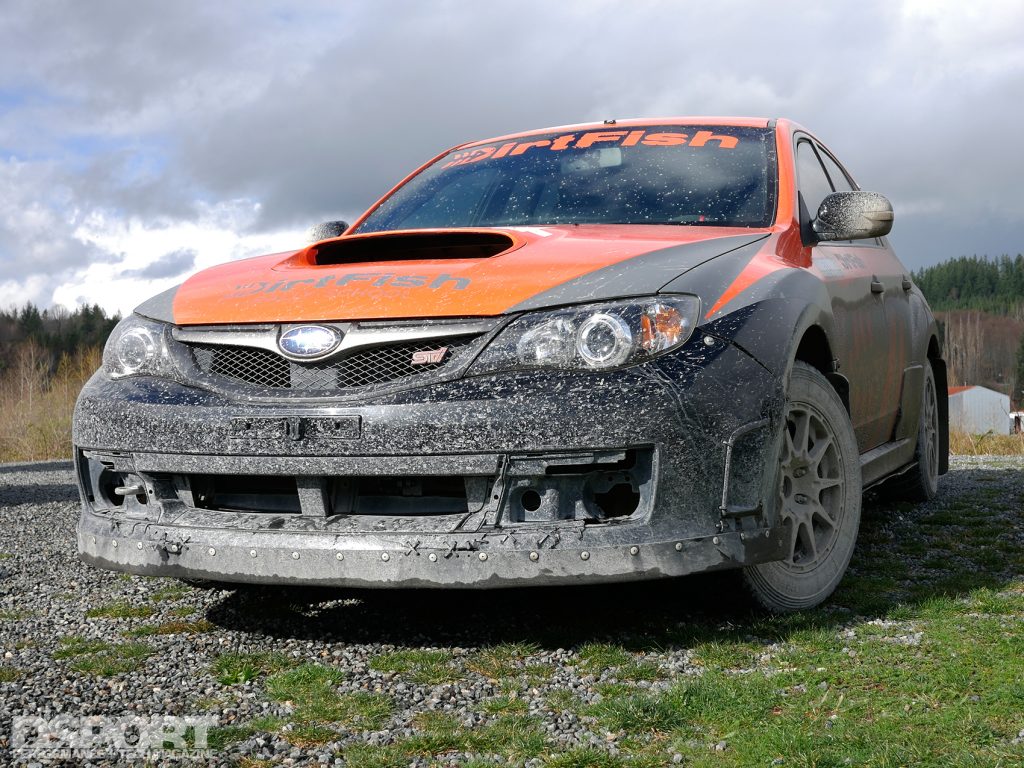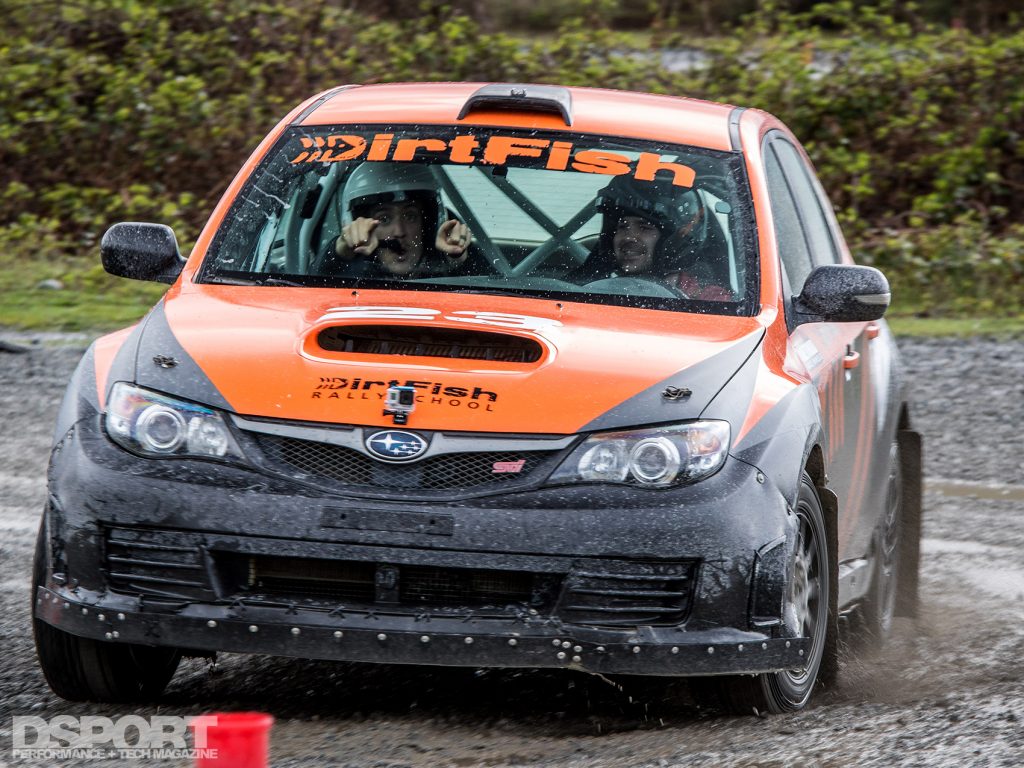If you think you’re any sort of skilled driver now, wait until you have a professional show you how fast you can really go. I come from more than a decade of road racing experience in a wide variety of four-wheeled machines, I’ve collected my share of wins and championships, and can even lay claim to a track record with my name on it. So what did all of this experience amount to when I first got behind the wheel of DirtFish Rally School’s Subaru WRX STIs? Almost nothing. Sure, I didn’t crash the car, I kept it on track and I felt like I drove pretty hard. But once I rode along with an instructor in the driver’s seat, the humbling experience revealed to me that I’d have a lot to learn in my three days of rally school.
Text by Cameron Parsons // Photos by Cameron Parsons and courtesy of DirtFish // Illustrations by Paul Laguette
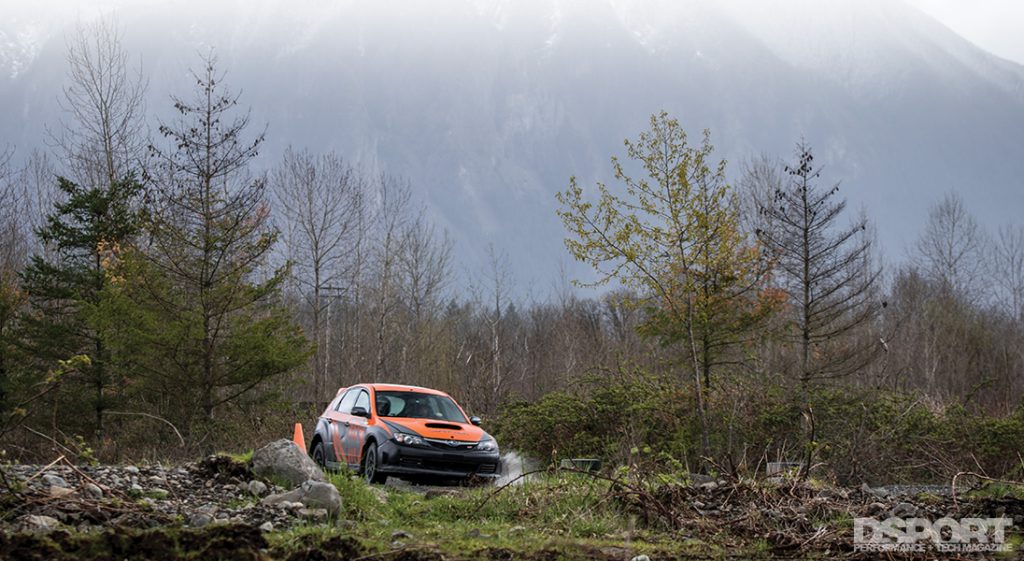 A New Language
A New Language
What driving techniques do you think you see when Global Rallycross or World Rally Championship drivers tear up the gravel and tarmac in their high horsepower, all-wheel drive monsters? Just crank the steering wheel, slam the gas, rinse and repeat, right? That’s what I used to think, before learning that rally racing actually demands a great deal of rhythm and finesse. Although rally cars respond slower than road racecars, they still react with great emphasis to driver inputs and vehicle weight transfer due to the road surfaces, so and tall tires, and long travel suspension.

Beyond an understanding of a vehicle’s handling dynamics, rally drivers must know how to read the road that lies ahead and anticipate variables like surface conditions, debris on course or visibility. To this end, the rally racing line is nearly opposite of any road racing line. In road racing, drivers aim to straighten out a turn as much as possible by starting from the outer edge, pulling the car to the inside apex, and then tracking out to the outer edge on the exit to carry momentum. Rally racing, however, emphasizes taking advantage of both straight-line braking and acceleration. Rally drivers brake late and in a straight line when possible, initiate an extremely late turn-in to get the car rotated, but aim to have it pointed nearly straight toward the inside or center of the exit instead of the outside. This gives drivers some wiggle room for error, as opposed to pushing the car to the very edge on the exit, only to be met by a tree or to drop off the side of a mountain.
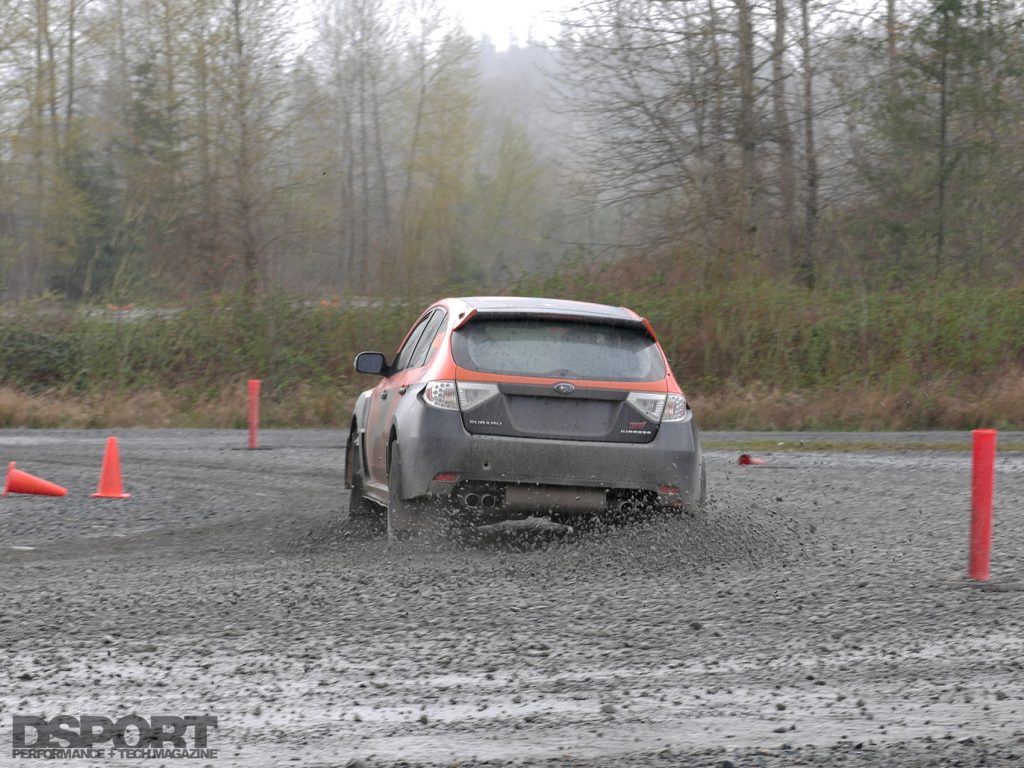
Rally On the Rise
Rally racing in the last 50 years went through a series of ups and downs, making it difficult for a rally racing school to operate effectively until just recently. In 1986, high costs and a series of unfortunate competitor and spectator fatalities led to the demise of the 500-horsepower Group B FIA Rally class, ultimately crippling overall interest in rally racing. Manufacturer disinterest, difficulties in effective television coverage and vehicle restrictions only wounded rally racing further.
However, the recent skyrocketing fame of wheel-to-wheel rallycross racing helped nudge all variants of rally back toward the spotlight. With the help of Global RallyCross Championship’s debut at the 2010 X Games 16, and names like Ken Block, Dave Mirra, Tanner Foust, Bucky Lasek and Travis Pastrana participating and promoting, rally racing has been steadily working its way back into popularity. The newfound success of stage rally and rallycross racing led to a growth of interest in participation everywhere, from local grassroots events to high-budget nationally broadcasted races. Given the popularity of the sport, DirtFish Rally School built its name in 2010 on a 315-acre plot in Snoqualmie, Washington, to help make rally more accessible to enthusiasts. This giant driving playground stretches over both gravel and tarmac surfaces, around a 100 year old former lumber mill and through scenic forestation.
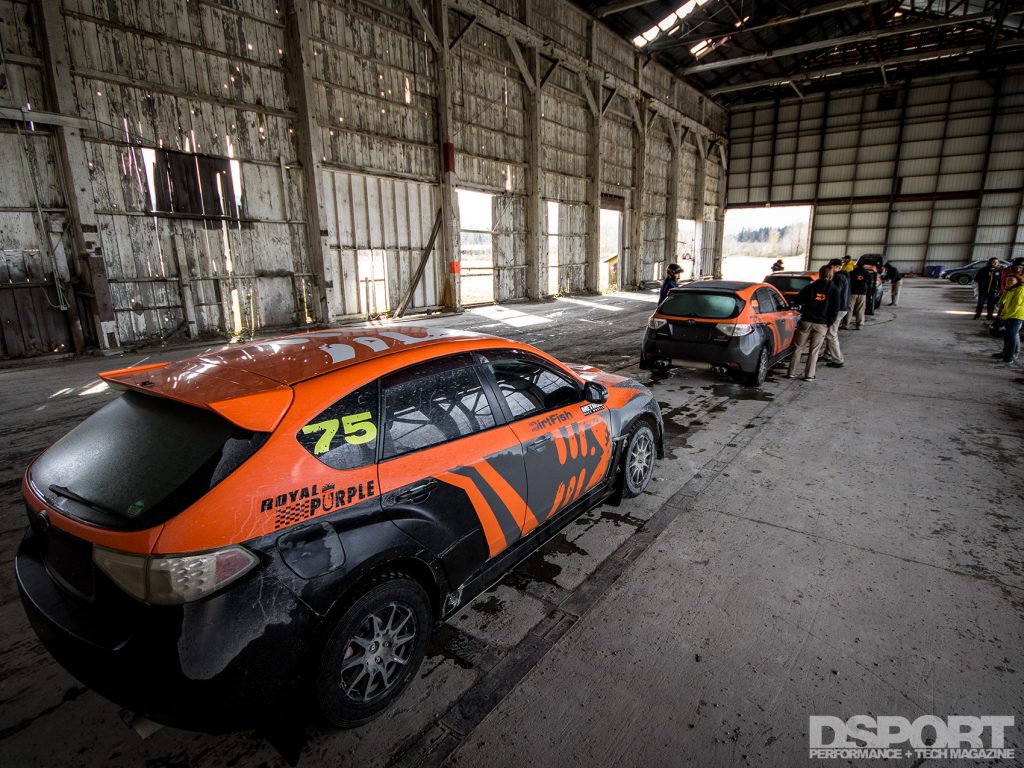
The Cars
Given Subaru’s fame and success in the facets of rally racing, DirtFish built a fleet of Subaru WRX STI sedans and hatchbacks to give students the full experience. The cars feature mildly modified EJ257 engines matched to a six-speed manual transmission and active differentials to put the power down through all four wheels. Reinforced suspension points and Reiger rally suspension add strength to handle the gravel rally tires over bumps and through turns. A roll cage fills the interior for occupant protection and chassis stiffness, while skid plates and underbody protection prevent gravel and debris from damaging the underside of the car. In line with most rally car builds, the DirtFish Subaru WRX STIs emphasized strength in the builds, in order to handle the abuse of rally racing (and student drivers).
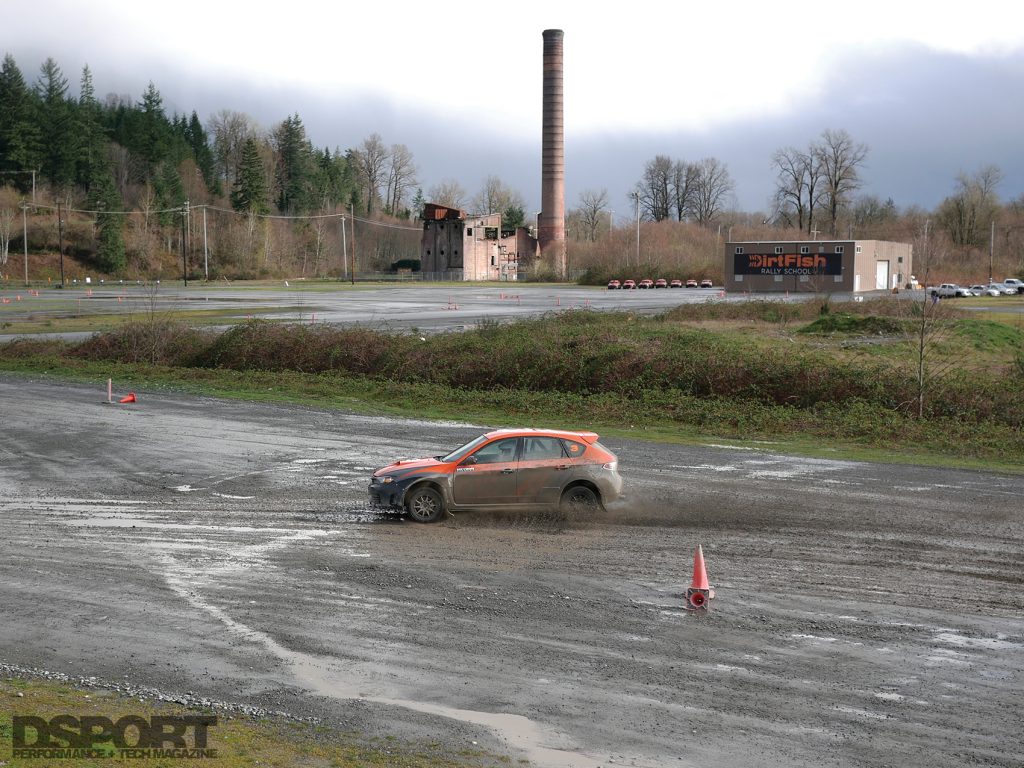
Day One: Back to School
I’ve participated in and worked for multiple racing schools, and I’ve never seen any school get its students in the driver’s seat so quickly. After just 30 minutes of introductions and rally driving basics in the classroom, we hit the gravel skidpad. Although this sounds risky to throw a group of students into cars and send them driving right off the bat, it actually went better than expected. Each student was paired with an instructor that demonstrated the exercise, and then swapped seats to receive one-on-one instruction.
In order to help us grasp the basics of car control, the instructors sent us driving in circles. This gave us the opportunity to play with the car inputs and get a feel for how they affected the cars’ balance at speed. This exercise led to one of the most important and frequently referred to lessons of each of the three days: lift, turn, brake. This may sound simple, but getting the timing right for this process felt like learning how to heel-toe downshift all over again. In many low and medium speed corners in a rally car, the driver first lifts off of the throttle to shift the weight of the car onto the front tires, then initiates the turn-in to take advantage of the extra front grip and begin rotation. Once the car begins rotating, the back end starts to very slightly drift out, but not enough. Applying the brakes shifts even more weight onto the front end, helping the back slide around even more to get the car lined up for the exit. Given these cars’ AWD configuration, the throttle pedal is the driver’s best tool for countering oversteer, as opposed to the steering wheel. To that end, the throttle is also the greatest proponent to causing understeer. Coming from RWD habits, I wanted to climb onto the throttle early and use it to help the car rotate, but this strategy repeatedly ended in pathetically slow corner exits. Patience became the key element, by waiting for the car to fully complete its rotation and line up straight for the corner exit before rolling back onto the throttle.

(1) The driver lifts completely off the throttle, transferring weight onto the front wheels. (2) With both feet off the pedals, the driver turns the wheel to begin rotation and initiate a slide. (3) Applying some brake encourages the car to slide even more, aiding to get it lined up for a straight-line exit. (4) The driver climbs back onto the throttle to stop the slide and send the car out of the turn with a strong exit speed.
Catching Zs
The rally racing lines turned into one of the most fun and most difficult concepts to grasp. Rather than driving a constant radius around any given corner, rally cars demand more of a point-and-shoot method. The lift, turn, brake technique emphasized this especially through the slaloms. Gravel surfaces don’t allow driving a smooth S-like curve between a series of cones without either spinning out or missing half the slalom completely. Instead, driving through in a Z-like pattern was encouraged, creating miniature straightaways in between each cone before getting the car sideways and pointed past the next one. By the end of the first day of class, composed or sloppy, every student comfortably drifted the Subarus on gravel.

Day Two: Whip It Around
In all three days of rally school, day two proved the most challenging. This is the day where all of the students, completed the first day’s exercises with all the confidence in the world and nowhere near the skill level to match.
First, we took our hand at handbrake turns. Similar to the other methods learned so far, the most effective strategy in executing a proper handbrake turn came down to timing. As you might guess, nobody completed this exercise without spinning out at least once.
The instructors only ramped up demands from there. We went back to the skidpad to practice trail-braking, and then dove into learning how to pull off one of the most famous rally driving moves, the Pendulum Turn, also known as the Scandinavian Flick. This move may not look like the quickest away around a turn, but it can prove extremely helpful when entering a turn from the wrong side of the road, or to gain extra rotation without the need for a handbrake.
Have you ever heard of a tank-slapper in road racing? This frequently occurs when the car enters a slide in one direction, the driver corrects, and the car suddenly regains grip and throws itself into a slide in the other direction. This is one of the worst situations that lead to a loss of control in road racing, yet it was the ultimate goal in performing a Pendulum Turn in the rally cars. With a left-hand turn laid out ahead, we were instructed to start on the left side of the straightaway leading to the turn. From there, we’d lift off the throttle, turn right and get on the brakes to create a slide. While riding the brakes, we’d then counter steer to control the slide and keep the weight planted on the front left tire. Then with a quick lift off the brake pedal, the car would snap around to drift the car appropriately around the left-hand corner. Surprisingly, after a short series of trial and error with plenty of instructor help, the entire class consistently executed the turn properly.

(1) The driver backs off the throttle and aggressively applies brake. (2) As the car decelerates, the driver slowly reduces brake pressure while starting to turn the wheel. (3) With the wheel turned, and little to no brake applied, the car continues to rotate. (4) The driver prevents oversteer primarily with the throttle, keeping the wheel as straight as possible and the car on the middle or inside of the course on corner exit.
Gravel versus Tarmac
The end of the second day brought out both the best and worst in many of us. The instructors outlined a course that stretched about a mile long, full of twists and turns that transitioned between gravel and tarmac. While driving this course, we had to deal with changing levels of grip in braking zones, acceleration zones and even mid-corner. This called for an emphasis on always looking ahead and analyzing the upcoming road surface, to plan on the gain or loss of grip that would occur. With the exception of a few of my classmates’ incidents, like backing a car into a wall, we started comfortably turning laps around this course of variable terrain. This exercise put in perspective how some of the fastest rally drivers hold a strong ability to not only execute excellent driving technique, but to also predict grip levels and the best racing line through a turn before they even arrive to it.
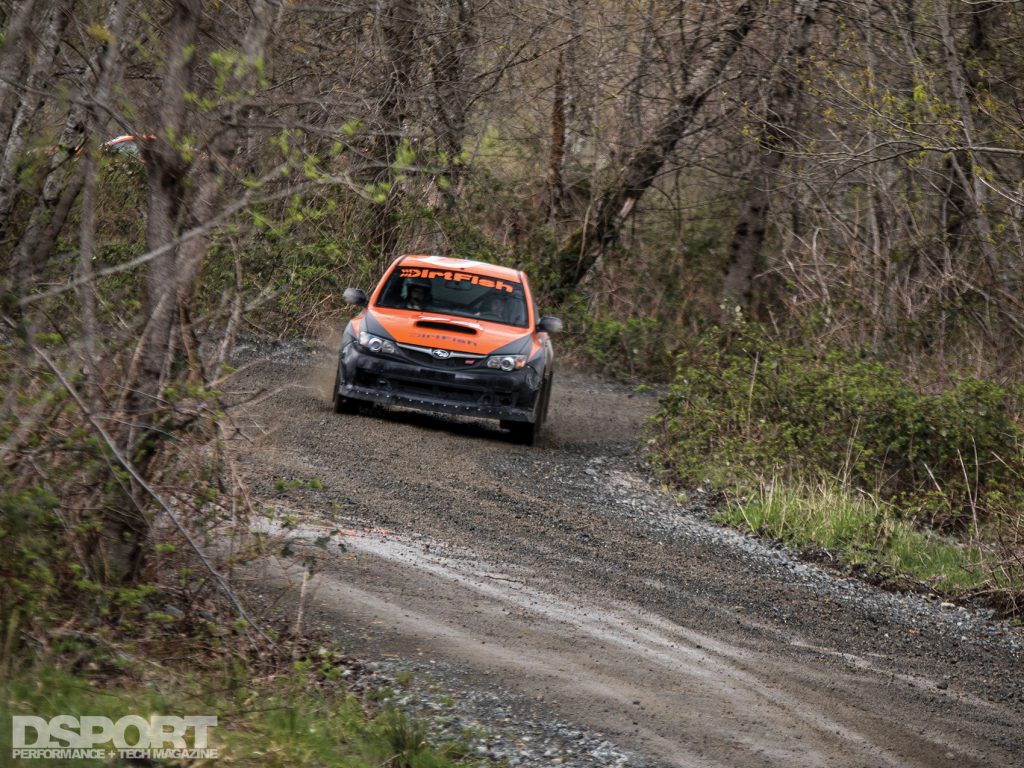
Day Three: Putting the Pieces Together
This was it, everything we’ve learned in the previous two days would add up to a successful run through the longest course of the program, hopefully without ending up in a water-filled ditch, wrapped around a tree, upside-down or on fire. We’d see higher speeds, harder braking and more sideways action than we’ve experienced thus far. The course sent us on a dirt and gravel path through the trees and alongside ditches, with sections ranging from tight 180-degree turns to high-speed bends with blind exits. It led back to alternating gravel and tarmac surfaces to keep us alert and ended on a muddy slalom. During my first attempt, I felt a mix of emotions, from complete terror to ear-to-ear grinning. Everything I learned over the last couple days left my memory as I slammed the brakes into turns, drifted the car left and right, and pinned the throttle on all the exits. I felt fast, I may have looked fast, but that first run turned out to be some of the worst driving I performed during the whole school.
With a deep breath and a mental reset, I decided to tackle the course in a more methodical way. Turn by turn, I reminded myself of the techniques that the instructors drilled into my mind, employing these methods to the best of my ability throughout the course. As a racing driver, I always strive to execute every corner perfectly. However, rally racing does not provide the opportunity to practice until you’re perfect. After six runs of changing weather and varying road conditions, I consistently built up my speeds, but never achieved the perfect run that I wanted. But that’s the reality of rally – nothing about the sport is consistent, and that’s what keeps it exciting.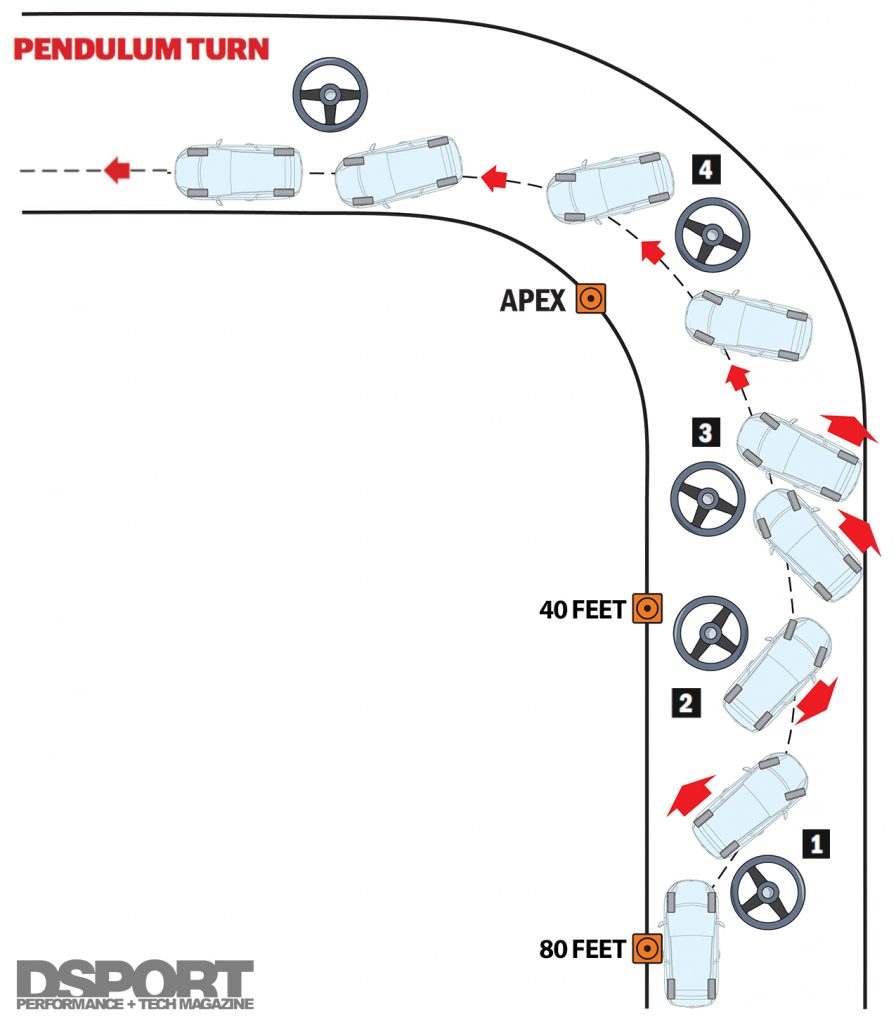
(1) The driver starts from the left side of the road for a left turn, and applies the lift, turn, brake technique toward the opposite direction of the corner. (2) While still on the brakes, most of the weight transfers onto the front left corner. The driver then counter steers to control the slide. (3) With a quick release of the brakes, the car whips around in the other direction for a quick but tidy rotation. (4) The driver applies throttle to straighten the car and exit the corner, keeping the wheel as straight as possible on the way out.
Driver’s Ed
I spent three days piloting a race-prepared rally car around a 315-acre playground, learning how to extract the most performance out of the car and myself as a driver. If anyone claims to walk away from this kind of experience unsatisfied, I wouldn’t believe them. After completing DirtFish’s three day rally school, my skillset still hardly matches that of any accomplished rally driver, but I walked away a better driver than I was before and had an unbelievable amount of fun.
SPEC SHEET
| VEHICLE | |
|---|---|
| Year / Make / Model: | 2010 Subaru Impreza WRX STI |
| Chassis Code: | GRB |
| Competition Class: | DirtFish Rally Program |
| Vehicle Weight: | 3,100 lbs |
| Shift RPM: | 5,500 RPM |
| Peak Boost: | 16 lbs |
| Fuel: | 92 Octane |
| ENGINE | |
|---|---|
| Engine Code: | EJ25 |
| Displacement (cc): | 2,500cc |
| Bore & Stroke (mm): | 99.5mm & 79mm |
| Peak Horsepower (@ RPM): | 305 hp |
| Peak Torque (@ RPM): | 290 lb-ft |
| Engine Builder: | Subaru |
| Pistons/Compression Ratio: | Wiseco forged pistons, 8.2:1 |
| Connecting Rods / Crank: | BC 625+ |
| Head Studs: | ARP |
| Air Induction System: | Re-routed through firewall |
| into glovebox | |
| Engine Management System: | Custom mapping |
| on factory ECU | |
| Exhaust System / Downpipe: | Invidia |
| Turbocharger: | Factory |
| CHASSIS/DRIVELINE | |
| Springs, F&R (Make & Rate): | Front: Reiger 40 kg |
| Rear: Bilstein 325 lb-ft | |
| Shocks, F&R (Make & Rate): | Front: Reiger 40 kg |
| Rear: Bilstein 325 lb-ft | |
| Transmission: | Factory |
| Clutch / Flywheel: | Exedy Stage 2 Clutch |
| Differential(s) (Make & Type): | Subaru electronically |
| controlled active differential | |
| Wheels (Make, Size & Offset): | Method Race Wheels MR501, |
| 15-inch, +48mm offset | |
| Tires (Make & Size): | DMACK 215/65/R15 |
| Brake Calipers (F&R): | Subaru WRX 4-Pot |
| Brake Rotors (Diameter, F&R): | 299mm |
| Brake Pads (Front & Rear): | Hawk Performance HP+ |
| Brake Lines: | Earls – 3 PTFE steel |
| braided lines | |
| INTERIOR | |
| Cage: | Custom-built in house |
| Seats: | Factory STI seats |
| Harnesses: | G Force 5-point harness |
| Steering Wheel: | Driven Steering Wheel |
